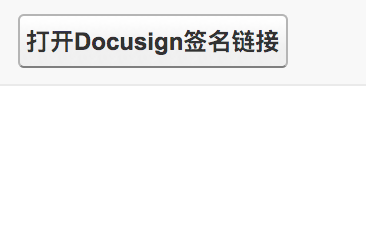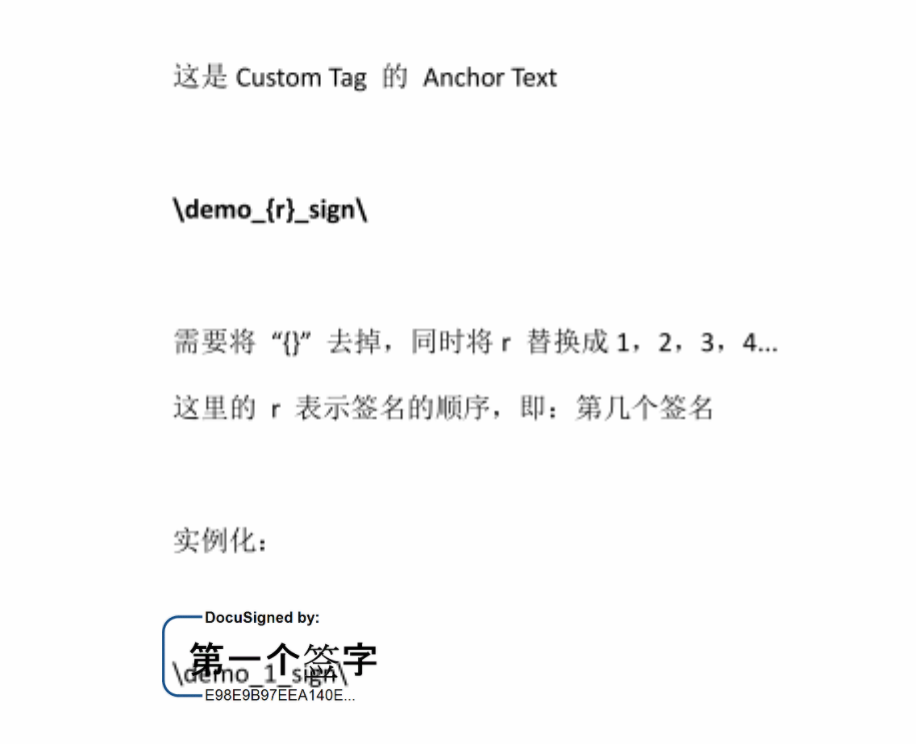之前谈到的Dicusign,都是发送一封邮件给到收件人,然后收件人完成签名的一个过程,那么有的时候,当我们需要直接在页面上打开用户签名的界面,而不是通过邮件的形式,那么就需要开启Docusign的嵌入式签名过程
整体步骤参考 Docusign系列(三)- SOAP方式调用Docusign,本质上来讲,嵌入式签名的形式,即将发送到用户的那封信件的链接,在页面上完成跳转,所以我们首先写一个页面按钮:打开Docusign签名链接(图左),当你点击按钮,会直接跳转到Docusign的签名页面(图右)


页面代码很简单,通过按钮调用Docusign的SOAP接口
<apex:page controller="ShowButtonCtrl" showHeader="false" sidebar="false"> <apex:form > <apex:pagemessages /> <apex:pageBlock > <apex:commandButton value="打开Docusign签名链接" action="{!testFunction}"/> </apex:pageBlock> </apex:form> </apex:page>
public class ShowButtonCtrl { public String testFunction(){ String docusignurl = DocusignDemo2.sendWithDocusign('8002w000000HXkJ'); return docusignurl; } }
那么关于Docusign部分的代码该怎么做呢?
首先是关于收件人,需要添加新的参数
// 设定一个 Client User Id String signer_user_id = '1'; // 第一个签字 DocusignApi.Recipient firstSigner = new DocusignApi.Recipient(); firstSigner.ID = 1; firstSigner.Type_x = 'Signer';// 收件人类型 - Signer表示需要签字 firstSigner.RoutingOrder = 1;// 签字顺序 firstSigner.Email = 'XXXXXXX'; firstSigner.UserName = '第一个签字'; firstSigner.RequireIDLookup = false; // 嵌入式签名的参数 firstSigner.CaptiveInfo = new DocuSignAPI.RecipientCaptiveInfo(); firstSigner.CaptiveInfo.ClientUserID = signer_user_id; firstSigner.CaptiveInfo.EmbeddedRecipientStartURL = 'SIGN_AT_DOCUSIGN';
然后在通过Docusign生成EnvelopeID之后,获取需要跳转的链接:
// 第一步:创建assertion DocuSignAPI.RequestRecipientTokenAuthenticationAssertion assertion = new DocuSignAPI.RequestRecipientTokenAuthenticationAssertion(); assertion.AssertionID = '1'; assertion.AuthenticationInstant = Datetime.now(); assertion.AuthenticationMethod = 'Password'; assertion.SecurityDomain = 'DS_Recipe_Signer_View_Controller'; // Salesforce 环境域名 String baseUrl = URL.getSalesforceBaseUrl().toExternalForm(); String signer_return_url = baseURL + '?cId=' + recordId; String return_url_base = signer_return_url; if(return_url_base.contains('?')) { return_url_base += '&event='; }else { return_url_base = return_url_base += '?event='; } System.debug(LoggingLevel.INFO , '**** return_url_base:' + return_url_base); // 第二步:为电子签名的不同结果创建重定向URL DocuSignAPI.RequestRecipientTokenClientURLs urls = new DocuSignAPI.RequestRecipientTokenClientURLs(); urls.OnSigningComplete = baseURL + '/apex/welcome?conId=' + recordId; urls.OnViewingComplete = return_url_base + 'viewing_complete'; urls.OnCancel = return_url_base + 'cancel'; urls.OnDecline = return_url_base + 'decline'; urls.OnSessionTimeout = return_url_base + 'session_timeout'; urls.OnTTLExpired = return_url_base + 'ttl_expired'; urls.OnException = baseURL + '/apex/welcome?conId=' + recordId; urls.OnAccessCodeFailed = return_url_base + 'failed_access_code'; urls.OnIdCheckFailed = return_url_base + 'failed_id_check'; urls.OnFaxPending = return_url_base + 'fax_pending'; System.debug(LoggingLevel.INFO , '**** return_url_base:' + return_url_base); String signer_view_url; Boolean no_error = true; try { // 第三步:调用Docusign请求 signer_view_url = dsApi.RequestRecipientToken(envelopeId, signer_user_id, firstSigner.UserName, firstSigner.Email, assertion, urls); System.debug(LoggingLevel.INFO , '**** Received signer_view_url:' + signer_view_url); } catch ( CalloutException e) { System.debug(LoggingLevel.INFO , '**** Exception - ' + e ); String error_code = 'Problem: ' + e; String error_message = error_code; no_error = false; }
在搞定上面的内容之后,当Docusign签订完成会跳转到 'welcome' 这个自定义页面,

整体来看,在SOAP的接触上使用嵌入式签名还是很简单的,这样就可以让Docusign能在更多的地方被使用,比如在我们发送出去的Email中,或者其他自定义页面上,赋予了这种电子签名更广泛的应用空间
需要注意的是,这种嵌入式签名的有效期仅仅五分钟,同时在默认情况下,Docusign不会发送之前我们看到的Docusign请求签名的邮件给收件人,这一点从需求上不难理解,毕竟在页面上把合同啥的都签了,也不需要额外的邮件提醒了,不过Docusign也不是完全关闭了这样的通道,在Docusign的管理员界面中,选择Signing Setting页签

在这里,你可以关闭或者启用是否要在嵌入式场景下发送邮件给签名者,同时设置一个 CaptiveInfo 参数(参数说明)
最后,附上DocusignDemo2 类的完整代码
public class DocusignDemo2 { public static String USERID = 'XXXXX'; public static String ACCOUNTID = 'XXXXX'; public static String PASSWORD = 'XXXXXX'; public static String INTEGRATORKEY = 'XXXXXX'; public static String ENDPOINT = 'https://demo.docusign.net/api/3.0/dsapi.asmx'; public static String sendWithDocusign(String recordId){ Contract con = [SELECT id FROM Contract WHERE Id=:recordId]; DocusignApi.DSAPIServiceSoap dsApi = new DocusignApi.DSAPIServiceSoap(); dsApi.endpoint_x = ENDPOINT; //Set Authentication String auth = '<DocuSignCredentials>' + '<Username>'+ USERID + '</Username>' + '<Password>' + PASSWORD + '</Password>' + '<IntegratorKey>' + INTEGRATORKEY + '</IntegratorKey>' + '</DocuSignCredentials>'; System.debug('Setting authentication to: ' + auth); dsApi.inputHttpHeaders_x = new Map<String, String>(); dsApi.inputHttpHeaders_x.put('X-DocuSign-Authentication', auth); // 发送Docusign中的模板 DocuSignAPI.TemplateReference templateReference = new DocuSignAPI.TemplateReference(); templateReference.Template = 'XXXXXXXXX'; templateReference.TemplateLocation = 'Server'; DocusignApi.ArrayOfTemplateReference templateReferences = new DocusignApi.ArrayOfTemplateReference(); templateReferences.TemplateReference = new DocusignApi.TemplateReference[]{templateReference}; // 设定一个 Client User Id String signer_user_id = '1'; // 第一个签字 DocusignApi.Recipient firstSigner = new DocusignApi.Recipient(); firstSigner.ID = 1; firstSigner.Type_x = 'Signer';// 收件人类型 - Signer表示需要签字 firstSigner.RoutingOrder = 1;// 签字顺序 firstSigner.Email = 'XXXXXX'; firstSigner.UserName = '第一个签字'; firstSigner.RequireIDLookup = false; // 启用嵌入式的同时启用远程签名 firstSigner.CaptiveInfo = new DocuSignAPI.RecipientCaptiveInfo(); firstSigner.CaptiveInfo.ClientUserID = signer_user_id;
// EmbeddedRecipientStartURL –这是发件人提供的用于重定向收件人的有效URL字符串。
// 使用此选项时,嵌入式收件人仍会像远程收件人一样从DocuSign接收电子邮件,但是当单击电子邮件中的文档链接时,
// 收件人将通过DocuSign重定向到该URL以完成其操作
// 路由到URL时,由发送者的系统(服务器响应URL)决定是否请求接收者令牌启动签名会话。
// 如果此节点使用值SIGN_AT_DOCUSIGN,则收件人将直接在DocuSign上定向到嵌入式签名或查看过程。
// 签名或查看操作由DocuSign系统启动,并且交易活动和完成证书记录将对此进行反映。在所有其他方面,
// 该过程与任何合作伙伴都会发起的嵌入式签名或查看操作相同
firstSigner.CaptiveInfo.EmbeddedRecipientStartURL = 'SIGN_AT_DOCUSIGN';
DocusignApi.ArrayOfRecipient1 recipients = new DocusignApi.ArrayOfRecipient1(); recipients.Recipient = new DocusignApi.Recipient[]{firstSigner}; DocusignApi.EnvelopeInformation envelopeInfo = new DocusignApi.EnvelopeInformation(); envelopeInfo.AccountId = ACCOUNTID; envelopeInfo.Subject = 'email subject';// Max 100 characters envelopeInfo.EmailBlurb = 'email message.';// Max 10000 characters DocusignApi.CustomField platformName = new DocusignApi.CustomField (); platformName.Name = 'PlatformName'; platformName.Value = 'Salesforce'; platformName.Show = 'False'; DocusignApi.CustomField appName = new DocusignApi.CustomField (); appName.Name = 'AppName'; appName.Value = 'DocuSignForSalesforce'; appName.Show = 'False'; DocusignApi.CustomField SFContract = new DocusignApi.CustomField (); SFContract.Name = '##SFContract'; SFContract.Value = recordId; SFContract.Show = 'False'; DocusignApi.CustomField DSFSSourceObjectId = new DocusignApi.CustomField (); DSFSSourceObjectId.Name = 'DSFSSourceObjectId'; DSFSSourceObjectId.Value = recordId + '~Contract'; DSFSSourceObjectId.Show = 'False'; DocusignApi.ArrayOfCustomField arrayOfCustomFields = new DocusignApi.ArrayOfCustomField(); arrayOfCustomFields.CustomField = new list<DocusignApi.CustomField>(); arrayOfCustomFields.CustomField.add(platformName); arrayOfCustomFields.CustomField.add(appName); arrayOfCustomFields.CustomField.add(SFContract); arrayOfCustomFields.CustomField.add(DSFSSourceObjectId); System.debug('*** arrayOfCustomFields:' + arrayOfCustomFields); envelopeInfo.CustomFields = arrayOfCustomFields; // 保留信封ID String envelopeId; try { DocusignApi.EnvelopeStatus es = dsApi.CreateEnvelopeFromTemplates(templateReferences,recipients,envelopeInfo,true); envelopeId = es.EnvelopeID; System.debug(LoggingLevel.INFO, '*** EnvelopeID:' + es.EnvelopeID); System.debug(LoggingLevel.INFO, '*** Status:' + es.Status); } catch ( CalloutException e) { System.debug('Exception - ' + e ); } // 第一步:创建assertion DocuSignAPI.RequestRecipientTokenAuthenticationAssertion assertion = new DocuSignAPI.RequestRecipientTokenAuthenticationAssertion(); assertion.AssertionID = '1'; assertion.AuthenticationInstant = Datetime.now(); assertion.AuthenticationMethod = 'Password'; assertion.SecurityDomain = 'DS_Recipe_Signer_View_Controller'; // Salesforce 环境域名 String baseUrl = URL.getSalesforceBaseUrl().toExternalForm(); String signer_return_url = baseURL + '?cId=' + recordId; String return_url_base = signer_return_url; if(return_url_base.contains('?')) { return_url_base += '&event='; }else { return_url_base = return_url_base += '?event='; } System.debug(LoggingLevel.INFO , '**** return_url_base:' + return_url_base); // 第二步:为电子签名的不同结果创建重定向URL DocuSignAPI.RequestRecipientTokenClientURLs urls = new DocuSignAPI.RequestRecipientTokenClientURLs(); urls.OnSigningComplete = baseURL + '/apex/welcome?conId=' + recordId; urls.OnViewingComplete = return_url_base + 'viewing_complete'; urls.OnCancel = return_url_base + 'cancel'; urls.OnDecline = return_url_base + 'decline'; urls.OnSessionTimeout = return_url_base + 'session_timeout'; urls.OnTTLExpired = return_url_base + 'ttl_expired'; // urls.OnException = return_url_base + 'exception'; urls.OnException = baseURL + '/apex/welcome?conId=' + recordId; urls.OnAccessCodeFailed = return_url_base + 'failed_access_code'; urls.OnIdCheckFailed = return_url_base + 'failed_id_check'; urls.OnFaxPending = return_url_base + 'fax_pending'; System.debug(LoggingLevel.INFO , '**** return_url_base:' + return_url_base); String signer_view_url; Boolean no_error = true; try { // 第三步:调用Docusign请求 signer_view_url = dsApi.RequestRecipientToken(envelopeId, signer_user_id, firstSigner.UserName, firstSigner.Email, assertion, urls); System.debug(LoggingLevel.INFO , '**** Received signer_view_url:' + signer_view_url); } catch ( CalloutException e) { System.debug(LoggingLevel.INFO , '**** Exception - ' + e ); String error_code = 'Problem: ' + e; String error_message = error_code; no_error = false; } String signingUrl; if (no_error) { signingUrl = signer_view_url; System.debug(LoggingLevel.INFO , '**** signingUrl:' + signingUrl); } return signingUrl; } }